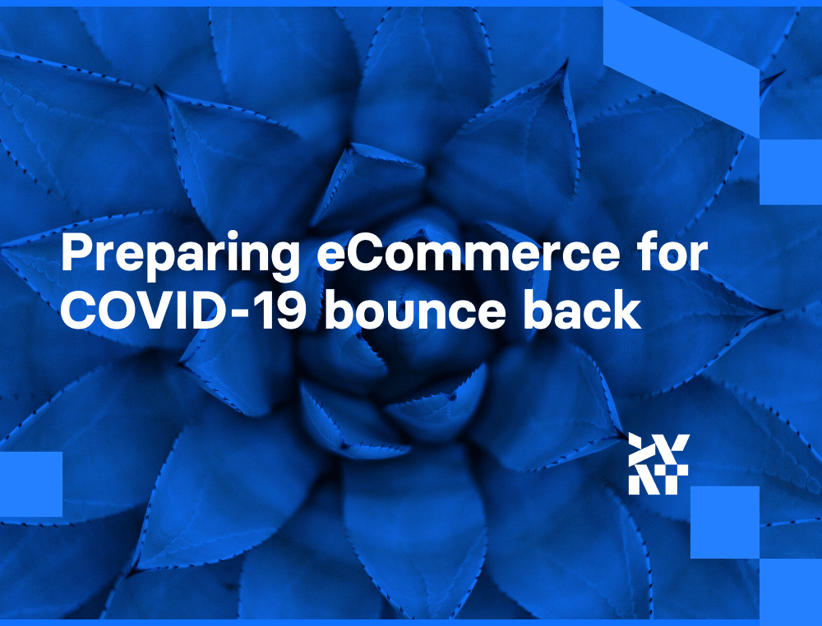How do you prepare your business for the future when the present is so uncertain? At the beginning of the pandemic, our CEO, Tomasz Karwatka, created an article outlining the possible scenarios depending on how the crisis unfolds and eventually abates. It’s a good first stop for anyone preparing eCommerce for COVID-19 bounce back.
We already know that the best-case scenario didn’t happen, as the summer did not put an end to the virus. The global number of cases is, in fact, still rising. However, the good news is that the World Health Organization is not predicting that the coronavirus will come and go in unpredictable waves.
“It’s going to be one big wave. It’s going to go up and down a bit. The best thing is to flatten it and turn it into just something lapping at your feet”
Margaret Harris, WHO spokesperson.
As we begin to have a clearer view of the long-term prognosis and the underlying trends, I’ve attempted to sum up what we know about the situation so far and how companies can go about preparing eCommerce for COVID-19 bounce back.
COVID-19 is boosting eCommerce sales in 2020
What we know for sure is that eCommerce internationally is growing significantly in recent months. eCommerce sales are up 55% year over year for the first seven months of 2020 as a result of a COVID-19 boosting digital sales. This amounts to $434.5 billion in online spending.
According to Adobe’s Digital Economy Index, the pandemic has resulted in $94 billion extra spent online since March. Only for July, online shopping reached $66.3 billion. The 55% year-on-year sales increase is impressive but, remarkably, the individual figures for May and June stood at 78% and 76%, respectively.
Adobe experts predict that, at current growth levels, 2020 online sales will surpass the total online sales in 2019 by 5 October 2020, before the holiday season sales even begin!
“Typically, when we look at growth in digital channels, it’s not surprising when a newer channel is seeing fast rates of growth. But eCommerce isn’t new, and before COVID-19, it saw much slower growth. The fact that even while states are starting to open up, the numbers remain so much higher than typical proves that things will never really go back to ‘normal.’ eCommerce is more embedded into our lives than it has ever been before and that is irreversible.”
John Copeland, Adobe’s VP of Marketing and Customer Insights.
Categories in which eCommerce is growing
eCommerce is posting good results in almost every category. The most obvious one is an online grocery, which has continued to grow throughout the pandemic. Overall sales are expected to grow +23,7% year on year.
The Home Furnishings category is even stronger, with an impressive +48,3% YoY increase. The market for handcrafted items (masks and home furnishings) has exploded during the pandemic. According to the recent report from digitalcommerce360.com, the total value of goods sold on Etsy.com and Reverb.com grew by 145.6% to $2.69 billion in the second quarter of 2020. Etsy alone grew 125% in Q2 year over year.
When we talk about preparing eCommerce for COVID-19 bounce back, the challenge for categories like online grocery and home furnishings will be to maintain as close to those dizzying heights as possible.
Fashion is struggling in-store and in some places online
There are some categories that have been hit hard by the coronavirus pandemic in general. The fashion industry is one of them. In May, sales at US clothing and accessories shops were down 62.4% compared to last year, while the retail sales of clothing, textiles, and footwear in Europe were 50.5% below their 2019 level.
In spite of the general trend, there are still success stories. Zalando, Europe’s largest online fashion retailer, reported on 15 July that its gross merchandise sales grew as much as 34% in the recent quarter, which is credited to shoppers buying more digitally. It said it had more than 3 million new customers and updated its guidance for the year to reflect that it now expects gross merchandise sales to rise by up to 25%.
Automotive sales have dropped in 2020 but can bounce back
A freeze in mobility was one of the most visible signs of the COVID-19 crisis. It has shaken the automotive industry. In China, for example, even though purchase intent is already back at pre-COVID-19 levels and sales in July were up 16.4% YoY, total vehicle sales in the first seven months of the year were down by almost 13%.
The situation in Europe is worse. The European Automobile Manufacturers’ Association (ACEA) currently forecasts a 25% drop in passenger car registrations in the European Union in 2020. The US is down 26% but also recovering. According to the McKinsey survey, demand for used cars appears more robust in the US and Asia, while in Europe, new car demand is seeing more reliable recovery.
“In both buying and servicing, a next normal seems to be emerging when it comes to how consumers want to buy and service their cars. Digital becomes more important along the entire purchase funnel, with half of the consumers being interested in online and contactless sales and service. Consumers anticipate increased online ordering of parts and DIY work.”
McKinsey.
A Capgemini survey points out that, despite car dealerships being open again, 60% of respondents in Germany say they would now be more likely to buy a car online. The article sums up that “the digitalization of the customer and purchase experience must be greatly accelerated.”
The coronavirus has accelerated the trend towards online shopping
The online shopping trend was already disrupting the retail industry before COVID-19 hit. That trend has, of course, been accelerated dramatically by shops being closed during the extended period of lockdown. Physical retail sales this year will fall by 14% to $4.184 trillion and it may take up to five years for offline sales to return to pre-pandemic levels.
25,000 brick-and-mortar retail stores in the United States are expected to permanently close this year, according to a report released by Coresight Research. It’s already happening. Spanish retailer Inditex, and its flagship Zara and Massimo Dutti clothing brands, announced a new strategy that includes investing 1 billion Euro in its digital operations while closing 1,200 physical stores.
It seems that major players are seeing an acceleration in the growth of digital channels and choosing to invest in that space. This is driven by a fundamental change in our attitude to online shopping and the confidence that previously resistant groups, such as older generations, have now been introduced to the benefits of online sales and will continue to use digital channels.
Preparing eCommerce for COVID-19 bounce back
We don’t know precisely how the coronavirus pandemic will develop further in 2020. A similar global lockdown is unlikely, as the governments are better prepared for the rapid growth of COVID-19 cases. We will certainly face challenges in the coming months but, with what we already know, we can prepare businesses based on some strong assumptions.
Reimagine the supply chain
One of the most painful lessons learned by the eCommerce business during the COVID-19 pandemic was that the global economy has come to rely upon supply chains that are vulnerable to disruption. eCommerce businesses must be able to deliver ordered products to customers on time. Without a flexible strategy to meet ongoing demand, shipping may be delayed or even canceled.
“It’s more important than ever that companies, as well as individual countries, boost the resilience of their value chains.”
McKinsey report.
The key is digitalization. Companies that digitized their value chains will benefit. Disruptions are unpredictable but digitization enables companies to react quickly and flexibly to unexpected situations and recover more rapidly. What’s more, people are making buying choices based on new and ever-changing circumstances, meaning that purchasing categories are also fast-changing. It’s yet another reason for having a flexible chain that can adapt to demand.
Recommended reading: Managing Growing Business Demand in a Time of Global Crisis
Understand and stay connected to your customers to keep them loyal
It’s generally easier to lose a customer than gain one. To cultivate loyalty, the eCommerce business needs to understand its customers and their needs, then deliver them a valuable and meaningful shopping experience.
As customers buy more online, they become more familiar with the possibilities on offer and start to demand more than before. If you understand their changing demands and take care of them, they will stay loyal. The Dotcom Distribution eCommerce consumer survey says that 24% of survey respondents reported the use of gift-like packaging encouraged them to buy again. 61% said the inclusion of a surprise giveaway with an online order would do the same. Interestingly, of those who prefer to pick up in-store, 31% often or always make additional purchases when picking up.

Customer support is also a great loyalty driver. Brands that connect with customers, and provide personalized recommendations and offers based on a customer’s behavior, are likely to gain an advantage. According to Forbes, customers spend 48% more when their shopping experience is personalized and 57% of online shoppers are comfortable sharing their personal information with a brand if it benefits their shopping experience. If eCommerce personalized is done right, the customer will feel the human touch that is the beginning of loyalty to a brand.
Looking to improve your online sales in response to the growth of eCommerce? Check the reasons why we recommend Shopware 6 for fast activation of online sales channels: - An introduction to Shopware 6 - Launching an online store in just 6 weeks - Migrating from Magento 1 to Shopware with an Akeneo PIM
eCommerce will continue to grow
eCommerce is growing even faster than before. Organizations have to invest in agility, flexibility, and adaptability to be prepared for uncertain times. The reimagining of the supply chain is vital but eCommerce also needs to stay connected to the customer and focus on loyalty.
Divante can help with preparing eCommerce for COVID-19 bounce back. We build great products and passionate communities around the technologies that are coming next. Wherever your imagination and ambition is taking your business, we build eCommerce solutions for present and future industry leaders.
Published September 4, 2020











